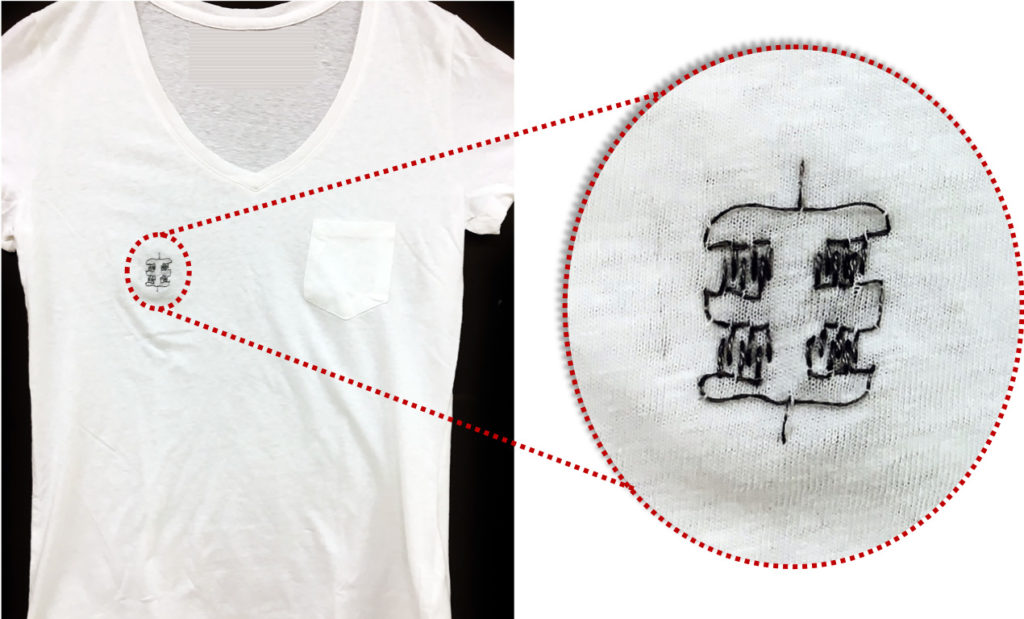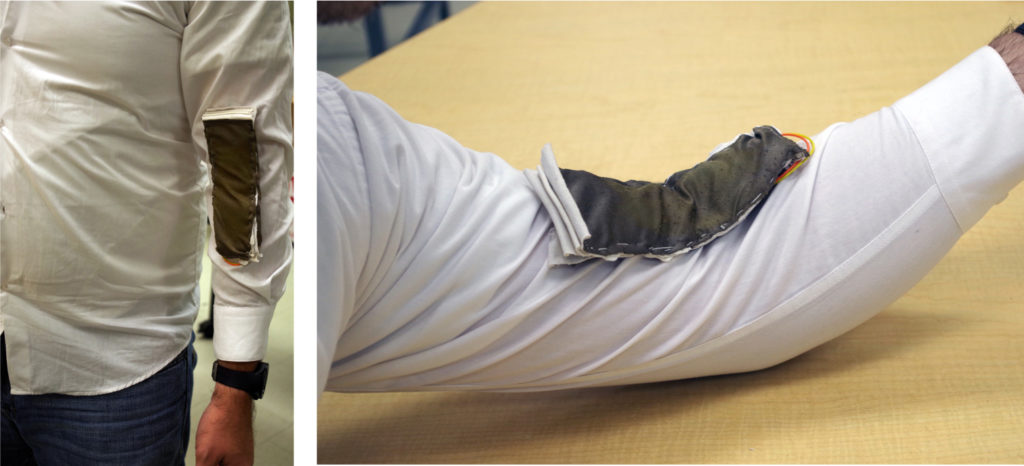Movement and health monitoring enters the next generation.
Editor’s note: Researchers at the University of Massachusetts Amherst (UMass Amherst) have had a series of breakthroughs in technologies that will improve health and wellness monitoring in smart garments. This article is a compilation of reports on this topic that were released by the university in recent months. ~ Janet Preus, senior editor

Computer scientist Deepak Ganesan, materials scientist Trisha Andrew and computer engineer Jeremy Gummeson received a grant to advance smart textiles, such as fabric patches sewn into shirts as seen here, that can provide light, care-free, continuous monitoring of movement. Photo: UMass Amherst/Trisha Andrew.
Wearable sensors that monitor movement, vital signs or other health indicators are transitioning into comfortable, carefree garments that do not require strap-on devices that can be lost or forgotten. Instead, researchers at the University of Massachusetts Amherst (UMass Amherst) say that fabric patches or smart threads can be an integral part of pants and shirts to enable health and wellness monitoring by doctors, therapists or athletic coaches.
Computer scientist Deepak Ganesan; materials scientist Trisha Andrew; chemistry and computer engineer Jeremy Gummeson at UMass Amherst’s Institute of Applied Life Sciences Center for Personalized Health Monitoring, received a three-year, $1.1 million grant in 2018 from the National Science Foundation’s Computer Systems Research program to continue their work in this area, the university reports.
Home health monitoring
Currently, if a physician wants to know details of how an elderly patient’s knee is contributing to unbalanced gait and risk of falling, monitoring that knee requires a visit to a special lab equipped with cameras and treadmills. Andrew, who directs the Wearable Electronics Lab at UMass Amherst, says that if pants made of a smart textile can be worn by the patient at home, monitoring can be done in the patient’s own environment.
“There we can collect data on how fast you are moving your knee in daily life, its range of motion, and whether it’s better or worse than your own personal normal,” she says, and adds, “We chose to work on knees and elbows to begin with, because they are points of motion, and you can’t do this type of monitoring by sticking your smart watch on your knee.”
Also, monitoring typically stops during sleep because patients don’t want to wear a device to bed. But Andrew says that monitoring with smart textiles during sleep could contribute important information.
As a materials chemist, Andrew is particularly interested in creating flexible, lightweight, washable and reuseable smart textiles. But smart fabrics must be paired with algorithms developed by computer scientists like Ganesan and hardware engineers like Gummeson who can calibrate the sensors, teach computers how to interpret incoming sensor data and help non-scientists make sense of it all.
Gummeson says medical scenarios that focus on improving elder care are one area where continuous sensing is exciting; athletic performance is another. With experience designing sensors in wireless research for the entertainment industry, he says, “If you think of the body as covered with textiles that all have opportunities for measurement, the possibilities are vastly larger than what could be previously achieved.”
Wearable batteries
A major factor that’s held back development of wearable biosensors for health monitoring is the lack of a lightweight, long-lasting power supply. Andrew and her team have developed a charge-storing system that is easily integrated into clothing using an embroidery pattern. This method uses a micro-supercapacitor and combines vapor-coated conductive threads with a polymer film, plus the sewing technique, to create a flexible mesh of aligned electrodes on a textile backing.
Andrew and postdoctoral researcher and first author Lushuai Zhang, and chemical engineering graduate student Wesley Viola, say that supercapacitors are ideal candidates for wearable charge storage circuits because they have inherently higher power densities compared to batteries.
However, “incorporating electrochemically active materials with high electrical conductivities and rapid ion transport into textiles is challenging,” they add. Andrew and colleagues show that their vapor-coating process creates porous, conducting polymer films on densely-twisted yarns, which can be easily swelled with electrolyte ions and maintain high-charge storage capacity per unit length, as compared to prior work with dyed or extruded fibers.
Andrew says that textile scientists have tended not to use vapor deposition because of technical difficulties and high costs, but more recently, research has shown that the technology can be scaled up and remain cost-effective.
Andrew and her team continue working with others at the UMass Amherst Institute for Applied Life Sciences’ Personalized Health Monitoring Center on incorporating the charge-storage arrays with e-textile sensors and low-power microprocessors to build smart garments.
The power of body heat
Many wearable biosensors, data transmitters and similar tech advances for personalized health monitoring have now been “creatively miniaturized,” says Andrew. A report provided by UMass Amherst News and Media Relations says that Andrew and Ph.D. student Linden Allison have developed a fabric that can harvest body heat to power small wearable microelectronics, such as activity trackers.
Writing in an edition of Advanced Materials Technologies, Andrew and Allison explain that in theory, body heat can produce power by taking advantage of the difference between body temperature and ambient cooler air, a “thermoelectric” effect. Materials with high electrical conductivity and low thermal conductivity can move electrical charge from a warm region toward a cooler one in this way.
Some research has shown that small amounts of power can be harvested from a human body over an eight-hour workday, but the special materials needed at present are very expensive, toxic or inefficient. Andrew says, “What we have developed is a way to inexpensively vapor-print biocompatible, flexible and lightweight polymer films made of everyday, abundant materials onto cotton fabrics that have high enough thermoelectric properties to yield fairly high thermal voltage, enough to power a small device.”
For this work, the researchers took advantage of the naturally low heat-transport properties of wool and cotton to create thermoelectric garments that can maintain a temperature gradient across a thermopile, an electronic device, which converts heat to electrical energy even over long periods of continuous wear. This is a practical consideration to insure that the conductive material is going to be electrically, mechanically and thermally stable over time, Andrew says.
The scientists created their all-fabric thermopile by vapor-printing a conducing polymer known as persistently p-doped poly(3,4-ethylenedioxythiophene) (PEDOT-Cl) onto one tight-weave and one medium-weave form of commercial cotton fabric. They then integrated this thermopile into a specially designed, wearable band that generates thermo-voltages greater than 20 milliVolts when worn on the hand.
The durability of the PEDOT-CI coating was tested by rubbing or laundering coated fabrics in warm water and assessing performance by scanning electron micrograph, which showed that the coating “did not crack, delaminate or mechanically wash away upon being laundered or abraded, confirming the mechanical ruggedness of the vapor-printed PEDOT-CI.”
They measured the surface electrical conductivity of the coatings using a custom-built probe and found that the looser weave cotton demonstrated higher conductivity than the tighter weave material. The conductivities of both fabrics “remained largely unchanged after rubbing and laundering,” they add.

Photo: UMass Amherst.
Loose clothing, no problem
In a paper presented at the SenSys 2018 Conference on Embedded Networked Sensor Systems in Shenzhen, China, UMass Amherst scientists introduced Tribexor, a fabric-based triboelectric joint-sensing system that can be integrated with loose-fitting clothing to sense a variety of joint movements such as flexion, extension and velocity of joint movement.
The team included electrical and computer engineering graduate students Ali Kiaghadi and Morgan Baima, with senior computer science researcher Gummeson, and professors Andrew and Ganesan.
A fundamental problem for smart garments is whether they can obtain useful signals from loosely worn clothing, Ganesan says. Many sensors, like inertial sensors and electromyography, require a tight fit to reduce motion artifacts and obtain a meaningful signal. But tight clothing is uncomfortable to wear and not appropriate in many applications such as elder care and patient care, he adds.
For their new device, the researchers used functionalized triboelectric fabric developed in Andrew’s materials chemistry lab. The fabric is comprised of layers that transfer surface charge from one layer to another and generate a voltage or current when compressed, tugged or twisted due to joint motion. This translates movement into an electrical signal and extracts useful information from loosely worn smart textiles.
Ganesan says, “Normally, loose fitting clothing would be considered a problem because that means we have to deal with a significant amount of noise, which is already a problem for relatively tight fitting devices like fitness bands.” But the Tribexor device turns this limitation into an advantage, he notes, because loose-fitting clothing can fold, compress and twist more.
The authors report that Tribexor has 95 percent accuracy for detecting elbow and knee flexion and extension movements and 85 percent accuracy for estimating angular velocity of the elbow and knee joints. It also accurately detects a variety of activities of daily living.
 TEXTILES.ORG
TEXTILES.ORG


